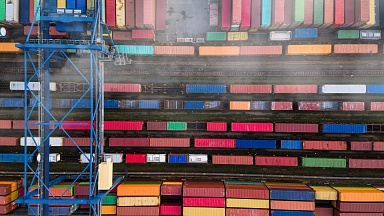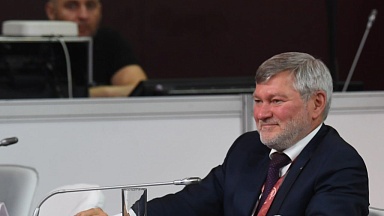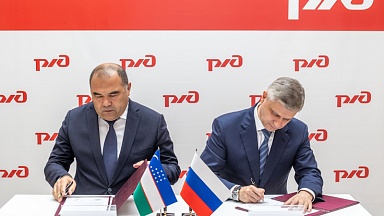In light of the sanctions pressure being applied by unfriendly countries, export-import cargo transportation logistics has been adapted and reoriented to Asia. China and friendly countries of the Asia-Pacific Region (APR) have emerged as the main commodities suppliers of the Russian Federation and the primary consumers of Russian goods. The main container cargo transportation routes pass through the Eastern polygon. Deputy General Director of Russian Railways JSC and Head of the Center for Corporate Transportation Service Alexei Shilo sat down with us today to talk about the results of transportation development along this route last year and what plans they have in store for 2024.
— What transportation dynamics were achieved via the Eastern polygon last year?
— By the end of 2023, loaded goods due East — to the roads located eastward of the limiting junctions of Mezhdurechensk and Mariinsk grew almost 5% over the year 2022, by 12.7 million tons, reaching 288.2 million tons.
Exports to the East over the period rose 7%, by 10.4 million tons, reaching 153.8 million tons. Seeing the most significant growth were coal with an uptick of 6.6% (6.7 million tons) uptick and high-tech containerized cargo whose shipments shot up 15.5% (2 million tons).
The volume of container transportation coursing through the stations of the Eastern polygon as of the end of last year amounted to 3.74 million TEUs (20-Foot Equivalent Units). That accounts for more than 50% of the total container transportation volume: in 2023, 7.4 million TEUs were shipped through the network, surpassing 2022’s totals in the same period by 14.1%.
1.23 million TEUs of loaded containers were transported in the direction of the Eastern polygon, which is 18.5% or 192 thousand TEUs more than in 2022. Of these, more than 1 million TEUs were shipped in container trains (an increase of 14.6%). The share of loaded containers delivered via this route was 84%.
In 2023, the Eastern polygon remained the priority destination for export cargo transportation. A total of about 963,000 loaded TEUs were exported through railroad checkpoints and ports located in the Eastern polygon, a big 44-percent jump of 293,000 TEUs over 2021 when many sanctions had not yet been imposed. The share of loaded container export shipments through the Eastern polygon in 2023 amounted to 62% of the total loaded export container traffic. Comparatively, in 2021, the figure was 45%.
As for the composition of goods transported in export containers in the direction of the Eastern polygon, the main types of cargoes were timber cargoes with a share of 41%, followed by paper at 18%, chemicals and soda at 10%, and grain with 9% of the total volume.
Import cargo transportation is playing just as important a role. In 2023, more than 1.25 million TEUs of loaded containers were shipped through the Eastern Range, which is 39% (349,000 TEUs) more than in 2022 and 69% (510,000 TEUs) more than in 2021. Import shipments’ share of loaded containers shipped through the Eastern polygon in 2023 was more than 74% of the total imported loaded container traffic.
The most common cargoes arriving in Russia include equipment with a share of 19%, industrial consumer goods with 17%, and automobiles with 14%.
Systemic measures taken to improve efficiency and utilize reserves in organizing cargo transportation set the stage for a new cargo transportation record in the China direction last year: transportation grew by 35.5% (42.2 million tons) to 161.1 million tons. This was facilitated, in part, by the development of multimodal service involving river, road, and rail transport aimed at relieving the load on the Far Eastern ports by delivering cargo along the Amur River to the rear terminals of the Far Eastern Directorate for Terminal and Warehouse Complex Management and further on — by train. The logistics chain includes transportation along the Amur River from the ports of Fuyuan and Tongjiang to the Khabarovsk River Trade Port, clearing customs, loading onto trucks of the Far Eastern Directorate, delivery to Khabarovsk-2 station, assembling cargoes and shipping them by rail.
A new scheme has been worked out along the Amur River through the Pokrovka — Zhaohe (PRC) border crossing point. Plans include a route to the south of China via the port of Vanino to seaports in the Chinese Guangdong province.
These adopted measures not only paved the way for new international logistics chains but also alleviated some of the burden placed on the limiting eastern destinations and seaports.
One of the links in the transportation & logistics chain of import and export supplies in the China-Kuzbass-China route was the first customs warehouse opened in August 2023 on the Russian Railways JSC infrastructure at the Kemerovo-Sortirovochnoye station terminal. The «RZD Import.RF» project helps companies importing goods into Russia reduce financial costs and ramp up delivery volume. 1,500 tons of goods, 100 new open top containers and three units of machinery have been placed there since the warehouse was opened. The customs warehouse clients enjoy comprehensive support that starts at the moment the goods are imported into the Russian territory to the point that they are released from the customs warehouse and the «last mile» is arranged.
— Do coal cargoes account for the bulk of transportation along the Eastern polygon?
— In organizing cargo exports via the infrastructure of the Eastern polygon, priority for transportation is established by the country’s leaders within the framework of particular instructions. This refers, first and foremost, to coal transportation under agreements with key coal-mining regions.
Thus, at the end of last year, taking into account the decisions adopted at a meeting with Andrey Belousov, First Deputy Prime Minister of the Russian Federation, Russian Railways JSC signed an agreement with six different regions. It envisages the export of hard coal in the eastern route from the enterprises of the Kemerovo Region in the amount of 54.1 million tons, the Republic of Khakassia — 6.5 million tons, the Republic of Tyva — 0.65 million tons, the Republic of Buryatia — 8.5 million tons, the Republic of Sakha (Yakutia) — 26.3 million tons, and the Irkutsk Region — 3.3 million tons.
Thus, 100 million tons of coal exports are planned for this year from the aforementioned regions. As a result, more than 60% of the limited transportation capacity of public infrastructure is used to ensure guaranteed export.
Furthermore, coal occupies a significant share in Russian domestic shipments to the East: last year, more than 58 million tons of coal was shipped to satisfy the needs of the domestic market, which is 43% of the total volume of domestic shipments in that direction. At the same time, the key objective today is to organize supply from Russian enterprises based on optimal logistics schemes. A significant volume of coal products shipped to meet their needs (in particular, to the power plants of RusHydro PJSC in the Far East) is transported over long distances. At the same time, coal companies located closer to ports, as well as those that have their own ports, do not exhibit much interest in making deliveries to energy companies.
As of the end of 2023, hard coal imports to enterprises in the Far Eastern Federal District from regions farther west reached 7.6 million tons. Such shipments have to travel as many as 5,300 km, and they significantly limit the opportunities of Russian exporters competing with them for infrastructure. Work in this respect is being carried out jointly with the Ministry of Energy of Russia to minimize suboptimal coal transportation.
Russian Railways JSC is utilizing all reserves to ensure maximum export of coal products to be transported to the roads of the Eastern polygon.
— Shippers’ competition for capacity in the Eastern polygon has intensified against the backdrop of the sanctions imposed, forcing exporters to redirect shipments from West to East. What is Russian Railways doing to meet shippers’ needs?
— Russian Railways is taking all possible measures to maximize cargo exports to friendly Asian countries.
The plans for BAM’s and the Trans-Siberian Railway’s development are being strictly adhered to. In late 2022, the Eastern polygon’s throughput capacity reached 158 million tons, which increased to 173 million tons in 2023, as stipulated by the Comprehensive Plan for the Modernization and Expansion of Trunk Infrastructure (CPMETI).
In light of the growing cargo traffic with China, works to develop overland railroad checkpoints, including Grodekovo, Kamyshovaya, Zabaikalsk, and Naushki, are underway. The potential of the new Nizhneleninskoye railway checkpoint, which opened at the end of 2022, is being developed as well.
In addition to the construction measures envisaged under the CPMETI, Russian Railways JSC is implementing a set of technological measures aimed at improving the efficiency of the existing infrastructure. These include the development of heavy-weight traffic, optimization of station operations, as well as driving connected freight and combined container trains. These solutions provide a means to maximize freight removal on the limiting sections of the infrastructure during the season of large-scale construction work in the summer months.
Timely adaptation of the transportation process to the new economic conditions was facilitated by the adoption of the Temporary Rules for the Prioritization of Freight Transportation in March 2022. They were adopted to replace the Rules for Non-Discriminatory Access to the Russian Railways network (RNDA). This document is based on the principle of balanced throughput capacity distribution between different cargoes based on their importance to the country’s economy.
At the same time, Russian Railways JSC is working to improve the Temporary Rules to meet the current needs of the transportation market. In particular, since their entry into force, a wide range of changes have been introduced affecting the transportation of timber and coal cargoes (in terms of prioritizing deliveries of products of enterprises with a raw material base) and agricultural and food cargoes (in terms of prioritizing such transportation in container trains). Priority for the transit of containers from unfriendly countries was also reduced, thus freeing up capacity for the export of domestic cargo.
In 2024, a new version of the RNDA for public railway transportation infrastructure, currently being developed by the Russian Federal Antimonopoly Service, is scheduled to go into effect. The new version of the RNDA will take into account the most effective solutions implemented in the Temporary Rules, which will eventually allow for striking a balance in transportation with due account for the interests of various sectors of the Russian industry.
— The Transport and Logistics Business Unit is taking an active part in the Russian Railways JSC program «Far Eastern Railway: an Advanced Development Area». What was accomplished last year?
— As freight transportation continued to trend east in 2023, we continued to develop domestic services, including digital services, as well as new routes to China, innovative solutions and enhanced technologies to enhance infrastructure utilization.
Traditionally, special attention has been paid to the promotion of transportation and logistics services for the benefit of small and medium-sized enterprises (SMEs). Together with the Central Directorate for Terminal and Warehouse Complex Management (CM), the company provides «Mobile Service» and «DM-Docker» services for the provision of special vehicles. «Open Doors Days» are regularly held at My Business MFC. The result: last year, 242 new SME customers were attracted (10% more than in 2022) and the annual SME loading volume was over 11 million tons (2.5 times, or 6.6 million tons more than, what it was three years ago).
Transportation containerization efforts did not stop. In cooperation with the Far East Railways, CM, Russian Railways Business Asset JSC, and shippers, the Company organized the shipment of containers from Far East ports, including using gondola car loading technology. As a result, their average daily export increased by 26% over the year (an increase of 651 TEUs per day over 2022) and reached 3.2 thousand TEUs. Container loading grew by 22% over the year to a record 1.3 mln TEUs.
The growth of containerization was fostered by the development of services in partnership with Russian Post JSC. Since June 2023, the new Stupino-Artyom-Primorsky route has been tested in addition to the main Moscow-Vladivostok Rossiya mail container train route.
In July, the first cross-border mail and e-commerce cargo acceleration transportation service was launched from China to Russia — in postal and baggage cars from Hunchun to Ussuriysk via the Hunchun-Kamyshovaya border crossing. The new technology aids the delivery of small consignments from China to Russia and back, as well as balance the distribution of the cargo base between the border crossings. Since November 2023, shipments from China have been made on a regular basis, twelve rides have been organized, and 221,900 parcels from China have been delivered to Russian residents.
The 2024 plans include increasing the number of shipments to three or four times a week. Our Chinese colleagues have shown great interest in the new service: the delivery time for goods has been cut back five to seven days, and the cost of transportation has decreased by 30% compared to road transport.
The new service will be a full-fledged alternative to road and air freight transportation in terms of delivery speed and cost. It is especially relevant for high-tech industry customers, as well as for companies engaged in cross-border Internet trade, including our SME customers.
To reduce the risks of hitting maximum capacity utilization, the Far Eastern Directorate for Terminal and Warehouse Complex Management is implementing a project to provide warehousing services on a one-stop-shop basis through service sales centers. It is designed for customers in need of the storage of cargo in closed premises, on open and crane platforms, loading and unloading operations, manual loading and unloading, including palletizing, and securing cargo in railcars.
For the first time in the Far East, the network has introduced a cargo storage service based on the capacities of the Supply Directorate as an alternative to using the warehouses of the Far Eastern Directorate for Terminal and Warehouse Complex Management, which entails the maximum capacity utilization risk. The service, launched in September 2023 at Ussuriysk station, is primarily intended for SME customers and is now being replicated across the network.



